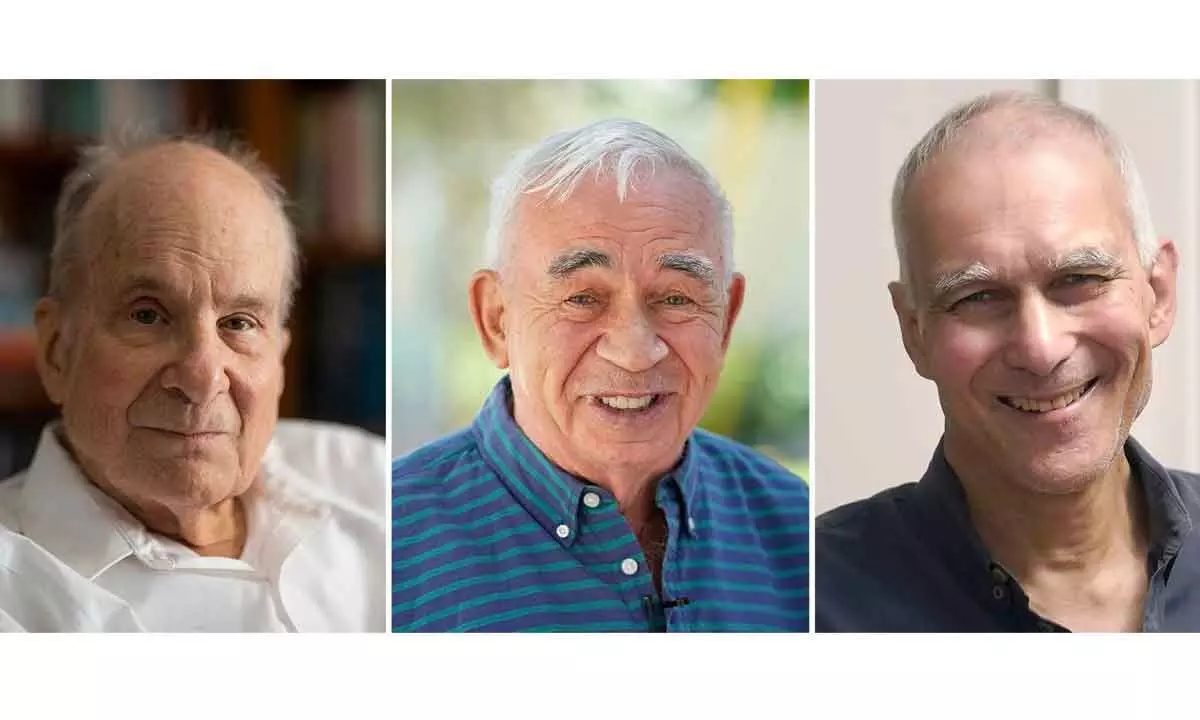Live
- Calcutta High Court stays order on demolition of hotels in Bengal’s Mandarmani
- AP Legislative Council Approves Key Bills
- WhatsApp Update: WhatsApp Rolls Out Group Mentions in Status Updates
- Czech PM, European Council President-elect discuss cooperation, EU priorities
- 47 killed, 22 injured in Israeli airstrikes on Lebanon's Baalbek-Hermel
- Chandrababu Advocates for Balanced Governance and Development in Andhra Pradesh
- Our 6 free services in Delhi pinching rivals: Kejriwal at 'Revadi par Charcha' campaign
- Abu Dhabi T10: Jos Buttler shines in debut, lauds England batters after memorable performances
- BCCI releases dates for IPL 2025 to 2027
- Centre releases Rs 448 crore as grant for rural local bodies in Karnataka
Just In
Chemistry Nobel goes to trio behind quantum dots


‘Very unfortunate’, says jury on leak of laureates’ names
Stockholm: Three scientists in the United States won the Nobel Prize in chemistry Wednesday for their work on quantum dots — particles just a few atoms in diameter that can release very bright colored light and whose applications in everyday life include electronics and medical imaging.
Moungi Bawendi, of MIT; Louis Brus, of Columbia University; and Alexei Ekimov, of Nanocrystals Technology Inc, were honoured for their work with the tiny particles that “have unique properties and now spread their light from television screens and LED lamps”, according to the Royal Swedish Academy of Sciences, which announced the award in Stockholm.
The suspense surrounding the academy's decision took an unusual turn when Swedish media reported the names of the winners several hours before the prize was announced. The advance notice apparently came from a news release sent out early by mistake. When asked about the mistake, Hans Ellegren, secretary general of the Royal Swedish Academy of Sciences, said it was ‘very unfortunate’ that the news was leaked.
Quantum dots are semiconducting crystals just a few nanometres wide. They are typically made from combinations of transition metals and/or metalloids – most commonly cadmium selenide and cadmium telluride – just like regular semiconductors.
Changing the size of a quantum dot changes its properties, in particular its fluorescence, meaning they can be tuned to produce different colours. The smaller the nanoparticle, the narrower the wavelength it emits – smaller dots emit blue light while larger ones emit red light.
In 1981, Ekimov a solid-state physicist working at the time at the Vavilov State Optical Institute in Russia, succeeded in creating size-dependent quantum effects in coloured glass. The colour came from nanoparticles of copper chloride and Ekimov demonstrated that the particle size affected the colour of the glass via quantum effects. This was the first time someone had succeeded in deliberately producing quantum dots.
A few years later, unaware of Ekimov’s study, Brus, a US chemist studying colloidal semiconductor nanocrystals at AT&T Bell Laboratories, became the first scientist to prove size-dependent quantum effects in particles floating freely in a solution.
He too understood that he had observed a size-dependent quantum effect.
Continuing with efforts to produce higher quality nanoparticles, in 1993 Bawendi, a research leader at the Massachusetts Institute of Technology in the US, had a major breakthrough when his group succeeded in growing nanocrystals of a specific size.
He was credited with revolutionising the chemical production of quantum dots, resulting in almost perfect particles – an essential step for them to then be mass produced. Now quantum dots are found in a wide range of commercial products, across scientific disciplines, from computer monitors and television screens based on QLED technology, to biomedical imaging.
‘Research is still very intense and there are applications expected or being heavily researched in producing photons for quantum communication, for flexible electronics for sensors for improving solar cells, making them better or cheaper … among many other things,’ said Heiner Linke, member of the Nobel committee for chemistry during the prize press conference.

© 2024 Hyderabad Media House Limited/The Hans India. All rights reserved. Powered by hocalwire.com






